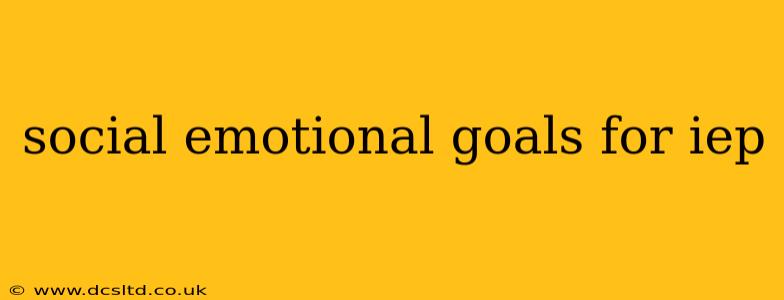Individualized Education Programs (IEPs) are crucial for students with disabilities, outlining specific goals and supports to help them succeed academically and socially. Social-emotional goals are a vital component of many IEPs, addressing crucial skills impacting a student's overall well-being and learning. This guide explores the creation and implementation of effective social-emotional goals for IEPs.
What are Social-Emotional Goals in an IEP?
Social-emotional goals in an IEP focus on developing a student's ability to understand and manage their emotions, build positive relationships, and navigate social situations effectively. These goals address areas like self-regulation, empathy, conflict resolution, and communication skills. They are not separate from academic goals; strong social-emotional skills are foundational to academic success.
Why are Social-Emotional Goals Important in IEPs?
Students with disabilities often face unique challenges in the social-emotional realm. These challenges can manifest as difficulty with self-control, anxiety, peer interactions, or understanding social cues. Addressing these challenges through specific, measurable goals in the IEP allows for targeted interventions and support, ultimately improving the student's overall quality of life and academic performance. A strong social-emotional foundation leads to increased engagement in learning, improved behavior, and enhanced relationships with peers and teachers.
Examples of Social-Emotional Goals for IEPs
Here are some examples of measurable and achievable social-emotional goals, categorized for clarity:
Self-Regulation & Emotional Control:
-
Goal: Student will demonstrate increased self-regulation by remaining in their assigned seat for at least 30 minutes during independent work time, with prompting, for 80% of school days. This will be measured via teacher observation and data collected on a daily checklist.
-
Goal: Student will identify and verbally express three different emotions (e.g., happy, sad, angry) they are feeling appropriately in response to various situations within a classroom setting during 4 out of 5 observations per week.
-
Goal: Student will use deep breathing techniques to calm themselves down when feeling frustrated, as observed by the teacher and documented on a daily behavior log for at least 4 days out of 5.
Social Interaction & Communication:
-
Goal: Student will initiate positive interactions with at least one peer during recess on 4 out of 5 days a week, as observed by the teacher and documented on a daily observation sheet.
-
Goal: Student will appropriately respond to peer invitations and requests (e.g., to play or share) on 8 out of 10 occasions, as recorded by the classroom aide.
-
Goal: Student will engage in cooperative group activities for a minimum of 15 minutes without disruptive behavior on 3 out of 5 days, as observed by the teacher.
Conflict Resolution & Problem-Solving:
-
Goal: Student will identify and verbalize two possible solutions to a conflict with a peer, without physical aggression, in 4 out of 5 conflict situations, as documented by the teacher or conflict mediator.
-
Goal: Student will use "I" statements to express their feelings during conflict resolution scenarios for at least 3 out of 4 observed instances, as documented by a peer mediator.
Empathy & Perspective-Taking:
-
Goal: Student will demonstrate empathy by offering verbal or non-verbal support to a peer in distress during at least 2 out of 3 observed instances, as observed by the teacher and documented on a weekly report.
-
Goal: Student will accurately identify the emotions of a peer in a picture book scenario 4 out of 5 times, as assessed through teacher-directed questioning.
How to Write Effective Social-Emotional Goals
To ensure your social-emotional goals are effective, remember the SMART criteria:
- Specific: Clearly define the behavior or skill.
- Measurable: How will you track progress?
- Achievable: Set realistic goals for the student's abilities.
- Relevant: Align the goals with the student's needs and IEP.
- Time-bound: Set a timeframe for achieving the goal.
Regular Monitoring and Progress Reports
Regular monitoring of progress towards social-emotional goals is critical. Data collection methods might include teacher observation, checklists, self-monitoring, and anecdotal records. Progress reports should clearly communicate the student's achievements and any challenges encountered.
By incorporating well-defined and measurable social-emotional goals into IEPs, educators can provide students with the support they need to develop essential life skills, ultimately fostering their academic success and overall well-being. Remember to involve the student, parents, and other relevant professionals in the goal-setting process for maximum effectiveness and buy-in.
